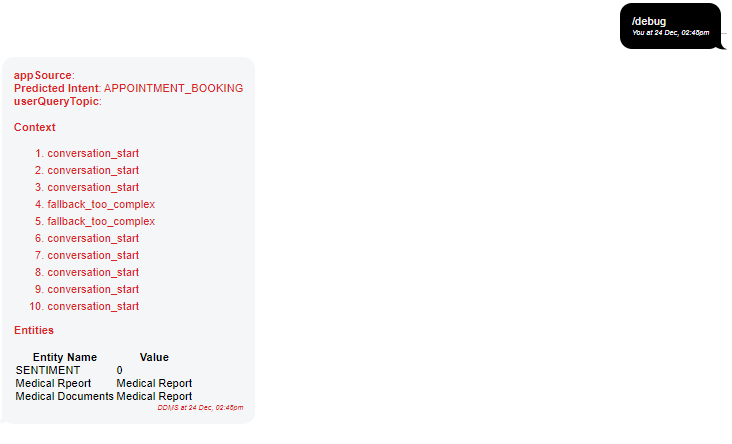How to troubleshoot when the response is incorrect
Troubleshoot effectively and pinpoint the issue when responses are incorrect. Follow steps to identify and resolve the problem swiftly.
Section-1 Summary Table
What could be wrong when I get the wrong answer?

Section-2 How to use /debug command
Use “/debug” to know the response details from the chatbot.

In the response of “/debug” the chatbot shares below details, the details provide direction for troubleshooting the issue.
- App Source- responded answer is configured for the Institution/Department/ Other App Source
- Predicted Intent- linked Intent with responded answer
- userQueryTopic- classification of Department/ Institutions
- Context- the previous content(s) that have been answered to the user
- Entities- Are there any entities which trigger this response
Section-3 Check the configuration in the Trigger
- Go to Editor’s Trigger tab.
- Search the Trigger with keywords of the response or content node
- Look for configured Trigger for below setups.
- Condition setup
- Keywords
- Context
- Action- review the configured Content Node here for the Trigger response.
- If required, add Positive test.
- Save the changes before testing.
- Always add App Source if you are adding a trigger for any institution/department/App Source.
Click here to get more details on how to set up Triggers.
Section-4 Check the FAQ if the responded answer is not pointing to the correct Intent.
- Go to the FAQ, and search the Intent.
- Open the Answer tab and review whether the Content Node is correct.
- If configured Content Node is not correctly linked, In “Actions” (“goto”) link the correct content node name, and save the changes.
- If configured Content Node is correctly linked, go to the Example tab, try to look through the training examples and review whether the Intent is wrongly trained with examples.
- If the example is wrongly trained.
- Move the example to the correct Intent.
- If the example has not been trained in any of the existing Intent
- Review whether example can be trained in existing Intents
- If it is a new topic and commonly asked question, create a new intent and add more training examples.
- If it is not a commonly asked question, add it to the KIV list or ignore it for now.
- Check conflict between Intents.
- If there are Intents which have conflict, search the examples which are conflicting in the Intents.
- Look for the examples in the conflicting Intents -if the Intents have any similar types of examples, clean-up similar examples by moving the example(s) to the correct Intent(s)
- If required, train the Intents with more real-life examples (queries from the end-users)
- Save the changes
- Train and publish new changes before testing in the Widget
Click here to get more details on how to manage FAQ.
Section-5 Check the Content Node in the Editor
- Go to the Editor, and search for the answer with keywords in the search bar.
- Look for the answer whether the configured answer is correct,
- If the answer is not correct, edit the answer and save it.
- If required, verify all the Content node versions by checking whether configured App Source is correct. Also, check that the default answer has been configured.
- If required, verify configured Conditions in the Content node, whether the conditions are set correctly.
- If required, verify the configured Entities in the Content node.
Click here to get more details on how to edit a Content Node.
Section-6 Check the Entities
- Go to the Entities menu.
- Verify whether the Synonym available in the user question is added to the Entity List
- Add more Synonyms if required.
- Check for duplication of the Entity List and the Synonyms – as it may lead to conflicts.
Click here to get more details on how to use Entities.
Section-7 Check the Conditions operator, if all above setup is correct (Section 3, 4, 5 & 6)
- Check if there are App Source or chat entry point conditions are set properly.
- If there is no condition is set up for the answer, it implies that the particular answer is the default universal response for the linked Intent.
- For Conditions, which operator to choose?
- “=” is the most precise operator. It signifies that out of complete list only selected value matches within the Entity. E.g. clinical services = blood test.
- “Includes”operator is used when a list includes the selected value, like left-hand side includes right-hand side.
- “Included in” operator is used when adding one or a few values within the Entity to detect. “included in”is also used as an OR mechanism. E.g. the public holidays Included in 2020-05-01, 2020-05-07, 2020-05-25, 2020-07-31 – this means that any of the dates are considered public holidays.
- “exists” and “not exists”operators.
- “exists” operator is used when the selected entire Entity (including all the values inside) is required as a condition.
- “not exists” operator is used when the selected entire Entity (including all the values inside) is not required as a condition.












